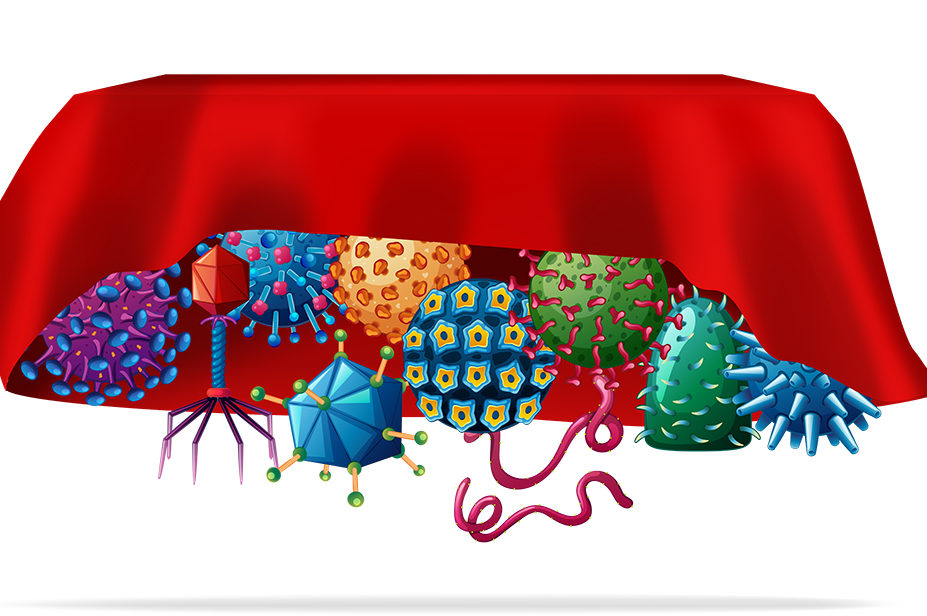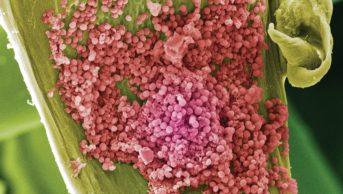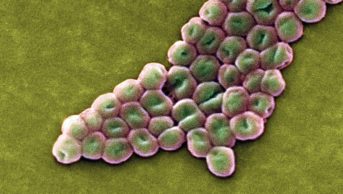
Mclean/Shutterstock
The COVID-19 pandemic has changed a lot of things. And, in our race to find effective treatments for the virus, it is even changing the way we have thought about drug development for more than a century.
Around 1900, biochemist Paul Ehrlich introduced the concept of the ‘magic bullet’ — a hypothetical drug that targets a given pathogen, with high specificity, without harming the host[1,2].
But no such magic bullet was available to us when COVID-19 emerged[3], and thousands of clinical trials to identify drugs to tackle the virus are still taking place around the world. It seems clear that a new magic bullet for a novel pandemic can be developed only after the pandemic has emerged[4].
In 2015, it was suggested that a third of drug approvals correspond to repurposing studies
If we are to be prepared for future pandemics, we must challenge the ‘one drug−one target’ paradigm. We cannot rely on magic bullets with specific targets — rather, we need ‘magic blankets’ in our pharmaceutical armoury.
These magic blankets are, what we at the University of Oxford are calling, ‘broad-spectrum therapeutics’ (BSTs): a class of antimicrobials that are active against many different types of pathogen, whether bacteria, fungi, virus or parasite.
We were not prepared
This is not a new idea. In 2007, the US Department of Health and Human Services’ ‘Strategic plan for biodefense research’ described the need for special drugs that can kill any pathogen to prepare for pandemics and bioterrorist threats[5,6].
Unfortunately, when SARS-CoV-2 emerged in 2019, no such drugs had formally been discovered, and many potential emergency treatments were put forward against the novel virus. This marked the first time that small-molecule drugs were used outside of their original antimicrobial classification on a global scale. One of these drugs, and perhaps the most infamous, was hydroxychloroquine — an antiparasitic drug. This is not uncommon: a myriad of antiparasitic and antibiotic drugs display antiviral activity.
Repurposing existing drugs
So far, no BST has been established through de novo discovery, but rather through drug repurposing, we can identify new uses for established drugs outside of their original indication. Drug repurposing is gaining momentum as a strategy to find new treatments; in fact, in 2015 it was suggested that a third of drug approvals correspond to repurposing studies, and 25% of the pharmaceutical industry’s annual revenue is generated by therapeutics that have been repurposed[7].
At the University of Oxford, we put forward a new formal BST classification, which would better prepare us for public health emergencies. This classification would speed up our ability to identify potential treatments in future pandemics without having to consolidate the repositioning histories of drug candidates after a pandemic is already underway.
Stacking the evidence
To this end, we sought to discern how ‘antiviral’ a given antibiotic or antiparasitic drug is, using the Drug Repositioning Evidence Level (DREL) system put forward by Oprea and Overington in their seminal review of drug repositioning studies in 2015[8]. Their DREL assessment was borne out of unsubstantiated claims for repositioning projects, and a lack of experimental evidence or corroboration with the literature.
In a similar fashion to classification schemes for quantifying drug−drug interactions, the DREL system ranks the quality of evidence from 0−4. The higher the DREL score, the stronger the evidence[9]:
- DREL 0: No evidence (this category includes in silico predictions with confirmation);
- DREL 1: In vitro studies with limited value for predicting in vivo/human situation;
- DREL 2: Animal studies with hypothetical relevance in humans;
- DREL 3: Incomplete studies in humans at the appropriate dose (for example, proof of concept; few cases from medical records; some clinical effects observed);
- DREL 4: Well documented clinical end points observed for repositioned drug at doses within safety limits.
As a measure of the pharmacological and clinical evidence of given drug against a particular disease, the DREL system gave us a simple but useful method of comparing the potential efficacy of any drug against COVID-19. When we put it to use in September 2020, we discovered something remarkable.
At least two of the drugs being trialled against COVID-19 were DREL 4 for more than one pathogen type (that is, clinically and pharmacologically effective against infection by more than one pathogen type). The first was azithromycin, a macrolide antibiotic used to treat malaria; the second, nitazoxanide, a broad-spectrum antiparasitic and antiviral agent that is effective against bacterial infections[10].
A new antimicrobial class
To our knowledge, these drugs represent the first of a new antimicrobial class: one that recognises drugs that are effective against multiple infection types. In our review of azithromycin, published in December 2020 — ‘Azithromycin: the first broad-spectrum therapeutic’ — we coined the aforementioned term ‘BST’ to describe this new drug class[10].
This term reflects both the broad pharmacological profile of these drugs as well as their wide-ranging applicability against different disease types. Using the DREL system, a particular BST can be given four different DREL scores, relating to each of the therapeutic types: antibiotic, antifungal, antiparasitic, and antiviral.
For example, a BST that is used clinically as an antimalarial and an antiviral but has not been studied as an antibiotic or antifungal is a 0:0:4:4 BST (antibiotic = 0; antifungal = 0; antiparasitic = 4; antiviral = 4). According to this system, azithromycin is a 4:0:4:2 BST, and nitazoxanide a 4:0:4:4 BST[10].
The new ‘network pharmacology’
Just as the discovery of antibiotics advanced our understanding of bacterial infection over the past century, we believe the discovery of BSTs will unearth infection mechanisms conserved across pathogen classes. Already, azithromycin’s lysosomotropic property (ability to penetrate cells’ lysosomes) has been shown to be useful against both malarial and viral infections.
An emergence of network pharmacology has been described as a paradigm shift in medicine
We also need to identify the cellular and nuclear signalling pathways targeted by BSTs; for example, azithromycin’s modulation of antiviral responses via IFNβ activation, or nitazoxanide’s inhibition of autophagy via ING1 upregulation. Having identified these pathways, we can improve our understanding of BST drug−disease interaction networks. This work will further contribute to a shift away from the ‘single drug−single target’ paradigm, and towards a polypharmacological one in which therapeutics engage multiple targets. This emergence of network pharmacology has already been described in the literature as a paradigm shift in medicine[11].
Blankets, not bullets
With repurposing studies ramping up, particularly amid the current pandemic, we expect new BSTs to be identified; and we point to ivermectin and niclosamide as potential BSTs in the near future[12,13]. At 4:0:4:2 and 4:0:4:4, respectively, azithromycin and nitazoxanide are not yet magic blankets, but almost. Soon, BSTs such as azithromycin can be replaced with more powerful 4:4:4:4 BSTs.
When a new virus emerges, we may not be able to kill it, but with BSTs we may be able to powerfully dampen its interaction with us, the hosts. Much in the same way as azithromycin today, host modulators of the future will be able to kickstart the host’s antiviral machinery; attenuate cell-mediated viral replication; and police the infection-induced inflammatory response.
The more we invoke prospective BSTs, such as ivermectin, to end the present pandemic, the more we will shift to broad-spectrum thinking[14]. In the face of another global health emergency, or potentially any new infection we discover, it’s unlikely we’ll be able to fire a magic bullet — instead, we’ll be ready to throw over a magic blanket.
Praveen Prathapan, former researcher, Department of Biochemistry, University of Oxford; research consultant; London
- 1Valent P, Groner B, Schumacher U, et al. Paul Ehrlich (1854-1915) and His Contributions to the Foundation and Birth of Translational Medicine. J Innate Immun 2016;8:111–20. doi:10.1159/000443526
- 2Strebhardt K, Ullrich A. Paul Ehrlich’s magic bullet concept: 100 years of progress. Nat Rev Cancer 2008;8:473–80. doi:10.1038/nrc2394
- 3Kouznetsov VV. COVID-19 treatment: Much research and testing, but far, few magic bullets against SARS-CoV-2 coronavirus. European Journal of Medicinal Chemistry 2020;203:112647. doi:10.1016/j.ejmech.2020.112647
- 4Allegrante JP, Auld ME, Natarajan S. Preventing COVID-19 and Its Sequela: “There Is No Magic Bullet… It’s Just Behaviors”. American Journal of Preventive Medicine 2020;59:288–92. doi:10.1016/j.amepre.2020.05.004
- 5Biodefense Strategic Plan. National Institute of Allergy and Infectious Diseases. 2007.https://www.niaid.nih.gov/research/biodefense-strategic-plan (accessed May 2021).
- 6Harrison C. Coronavirus puts drug repurposing on the fast track. Nat Biotechnol 2020;38:379–81. doi:10.1038/d41587-020-00003-1
- 7Talevi A, Bellera CL. Challenges and opportunities with drug repurposing: finding strategies to find alternative uses of therapeutics. Expert Opinion on Drug Discovery 2019;15:397–401. doi:10.1080/17460441.2020.1704729
- 8Oprea TI, Overington JP. Computational and practical aspects of drug repositioning. Assay Drug Dev Technol 2015;13:299–306. doi:10.1089/adt.2015.29011.tiodrrr.
- 9Firth A, Prathapan P. Broad-spectrum therapeutics: A new antimicrobial class. Current Research in Pharmacology and Drug Discovery 2021;2:100011. doi:10.1016/j.crphar.2020.100011
- 10Firth A, Prathapan P. Azithromycin: The First Broad-spectrum Therapeutic. European Journal of Medicinal Chemistry 2020;207:112739. doi:10.1016/j.ejmech.2020.112739
- 11Hopkins AL. Network pharmacology: the next paradigm in drug discovery. Nat Chem Biol 2008;4:682–90. doi:10.1038/nchembio.118
- 12Crump A. Ivermectin: enigmatic multifaceted ‘wonder’ drug continues to surprise and exceed expectations. J Antibiot 2017;70:495–505. doi:10.1038/ja.2017.11
- 13Xu J, Shi P-Y, Li H, et al. Broad Spectrum Antiviral Agent Niclosamide and Its Therapeutic Potential. ACS Infect Dis 2020;6:909–15. doi:10.1021/acsinfecdis.0c00052
- 14Kory P, Meduri GU, Varon J, et al. Review of the Emerging Evidence Demonstrating the Efficacy of Ivermectin in the Prophylaxis and Treatment of COVID-19. American Journal of Therapeutics 2021;28:e299–318. doi:10.1097/mjt.0000000000001377


